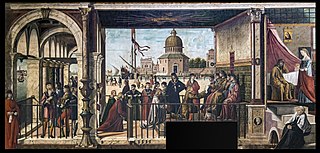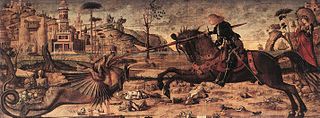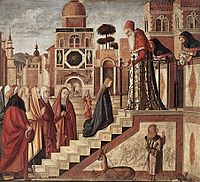
Vittore Carpaccio (UK: /kɑːrˈpætʃ oʊ/, US: /-ˈpɑːtʃ-/, Italian: [vitˈtoːre karˈpattʃo]; was an Italian painter of the Venetian school who studied under Gentile Bellini. Carpaccio was largely influenced by the style of the early Italian Renaissance painter Antonello da Messina, as well as Early Netherlandish painting. Although often compared to his mentor Gentile Bellini, Vittore Carpaccio's command of perspective, precise attention to architectural detail, themes of death, and use of bold color differentiated him from other Italian Renaissance artists. Many of his works display the religious themes and cross-cultural elements of art at the time; his portrayal of St. Augustine in His Study from 1502, reflects the popularity of collecting "exotic" and highly desired objects from different cultures.

The Gallerie dell'Accademia is a museum gallery of pre-19th-century art in Venice, northern Italy. It is housed in the Scuola della Carità on the south bank of the Grand Canal, within the sestiere of Dorsoduro. It was originally the gallery of the Accademia di Belle Arti di Venezia, the art academy of Venice, from which it became independent in 1879, and for which the Ponte dell'Accademia and the Accademia boat landing station for the vaporetto water bus are named. The two institutions remained in the same building until 2004, when the art school moved to the Ospedale degli Incurabili.

The Scuola Grande di San Marco is a building in Venice, Italy, designed by the well-known Venetian architects Pietro Lombardo, Mauro Codussi, and Bartolomeo Bon. It was originally the home to one of the Scuole Grandi of Venice, or six major confraternities, but is now the city's hospital. It faces the Campo Santi Giovanni e Paolo, one of the largest squares in the city.

The Scuola Grande di San Giovanni Evangelista is a confraternity building located in the San Polo sestiere of the Italian city of Venice. Founded in the 13th century by a group of flagellants it was later to become one of the five Scuole Grandi of Venice. These organisations provided a variety of charitable functions in the city as well as becoming patrons of the arts. The Scuola Grande di San Giovanni Evangelista is notable for housing a relic of the true cross and for the series of paintings it commissioned from a number of famous Venetian artists depicting Miracles of the Holy Cross. No longer in the school, these came into public ownership during the Napoleonic era and are now housed in the Gallerie dell'Accademia. The scuola is open to visitors on a limited number of days, detailed on the official website.

The Legend of Saint Ursula is a series of large wall-paintings on canvas by the Italian Renaissance artist Vittore Carpaccio, commissioned by the Loredan family and originally created for the Scuola di Sant'Orsola (Ursula) in Venice, which was under their patronage. They are now in the Gallerie dell'Accademia in Venice.

The Christ between Four Angels and the Instruments of the Passion is a painting by the Italian Renaissance master Vittore Carpaccio, executed in 1496 and now housed in the Civici musei e gallerie di storia e arte of Udine, northern Italy.

St. Augustine in His Study is an oil and tempera on canvas painting by the Italian Renaissance artist Vittore Carpaccio housed in the Scuola di San Giorgio degli Schiavoni of Venice, northern Italy. The painting depicts St. Augustine while he has a vision while sitting in a large room filled with objects. The study, or stuliolo, that was a one way that Italian aristocrats and collectors that displayed wealth, power, taste, and worldly knowledge. Carpaccio intentionally opens up the study to the viewer, revealing a vast amount of objects that have different origins and meanings. The artist signed the work on the small plaque, or cartellino, in the foreground near the dogs that reads: "VICTOR / CARPATHIVS / FINGEBAT".

St. George and the Dragon is a tempera on canvas painting by the Italian Renaissance artist Vittore Carpaccio. It is housed in the Scuola di San Giorgio degli Schiavoni of Venice, northern Italy.

The Scuola di San Giorgio degli Schiavoni in Venice, northern Italy, was one of the city's confraternities, a scuola piccola located in the sestiere (neighborhood) of Castello, Venice. Its building has been preserved.

The Sermon of Saint Stephen is an oil-on-canvas by Italian artist of the Venetian school Vittore Carpaccio, painted in 1514. It is now in the Louvre in Paris.

The Procession in St. Mark's Square is a tempera-on-canvas painting by Italian Renaissance artist Gentile Bellini, dating from c. 1496. It is housed in the Gallerie dell'Accademia in Venice.

The Miracle of the Cross at the Ponte di Rialto, also known as The Healing of the Madman, is a painting by Italian Renaissance artist Vittore Carpaccio, dating from c. 1496. It is now housed at the Gallerie dell'Accademia in Venice.

The Scuola di Santa Maria degli Albanesi was a confraternity, a Scuola Piccola, for Albanian Christians Catholics, in Venice, northern Italy. Its building subsists.

St. Mark Preaching in Alexandria is an oil painting by the Italian Renaissance artists Gentile and Giovanni Bellini, dated to 1504–1507, and held in the Pinacoteca di Brera, in Milan.

San Vittore is a parish church of the Roman Catholic Archdiocese of Milan in Esino Lario, Province of Lecco, Italy. It is located on a rocky outcrop and is dedicated to Victor Maurus, who died circa 303 in Milan.

Pietà or The Dead Christ Supported by the Virgin Mary and St John the Evangelist is a c. 1465–1470 tempera-on-panel painting by the Italian Renaissance artist Giovanni Bellini, now in the Pinacoteca di Brera in Milan.

The Barbarigo Altarpiece or Enthroned Madonna and Child with Angel Musicians and Saint Mark, Saint Augustine and Doge Agostino Barbarigo is a 1488 oil painting on canvas by Giovanni Bellini, now in the church of San Pietro Martire in Murano.
Save Venice Inc. is a U.S. non-profit organization dedicated to the conservation of art and architecture and the preservation of cultural heritage sites in Venice, Italy. Headquartered in New York City, it has an office in Venice, a chapter in Boston, and supporters across the United States and Europe.

Madonna and Child with Four Saints is an oil on canvas painting by Moretto da Brescia, executed c. 1543, now in the Pinacoteca di Brera in Milan, to which it moved during the Napoleonic seizures in 1808. It was painted for the church of Santa Maria degli Angeli in Gardone Val Trompia. In the foreground are the saints Jerome, Francis of Assisi and Anthony the Great.
The Scuole Piccole of Venice are confraternities in the Republic of Venice. Unlike the more famous Scuole Grandi, membership in them was not restricted to citizens and indeed some of them were formed specifically for foreigners. Most Scuole, the scolae communes, were devoted to a particular saint or devotional cult, but some, the scuole delle arti, were associated with specific crafts or trade guild, and often obligatory for the members of that trade.























